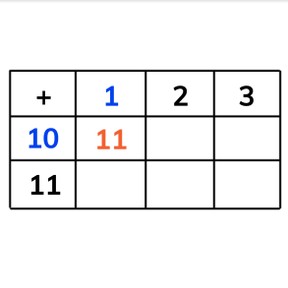



8,000 schools use Gynzy
92,000 teachers use Gynzy
1,600,000 students use Gynzy
General
Students learn to add to 20 by adding one more. They make use of an addition table.
Common core standard(s)
-1.OA.C
Relevance
Discuss with students that it is useful to be able to add with one more. If you know when you can simply add one more, you don't need to calculate sets of problems separately.
Introduction
Have a ball and say the number 6. Throw the ball to a student, and they must catch it and say the next number. They throw to another student, who also counts one higher. Continue throwing until you reach 20. Restart, but this time start at 12. Continue until you reach 20. On the interactive whiteboard, show the number sequence. There are jerseys hanging in order, but a few are missing. Have students drag the missing jerseys to their spot n the number sequence.
Development
Show the tennis balls on the interactive whiteboard. Say that there are 10 and one more is added. Together there are eleven tennis balls. Discuss the other problems shown by the tennis balls. Ask students if they notice anything about the totals of these addition problems. Say that only one tennis ball is added each time. Tell students that you can use an addition table to show addition problems where one is added each time. Explain how to read the addition table. Show this with a completed addition table. Point to the 10 on the left hand side, and say that you add the blue one at the top of the table to the 10. Their total is 11. Repeat this explanation for the following addition problems. Ask students what they notice about the answers- they are one more each time. Discuss that once you know the answer to the first addition problem, you only need to add one more to the previous total. You don't need to calculate the entire problem again. Ask students which numbers are missing from the addition table. Next, give each student a number card and you point to an empty space on the addition table. If a student believes that their number belongs in that space, they hold up their card. Have the students complete the table on a sheet of paper and have them hold it up to check their work.
Check that students understand addition to 20 with one more and using the addition table by asking the following questions:
- What do you need to calculate first to make the rest of the addition problems easier?
- 12+2= 14, What are the totals of the problems that come after? 12+3 = and 112+4=?
Guided practice
Students practice adding by counting one more by completing the addition tables.
Closing
Discuss with students that it is important to be able to add to 20 with adding one more, because sometimes you are able to calculate a set of addition problems without calculating each problem separately. Show the addition table on the interactive whiteboard and and have students discuss in pairs which numbers are missing. Ask how they determined the answers, did they calculate each problem separately or did they calculate the first problem and then add one more?
Teaching tips
Students who have difficulty adding with one more can make use of MAB blocks or other manipulatives. Have them set out blocks to represent the first addition problem, and then add one more block each time they add one more.
Instruction materials
A ball, number cards to 20
Optional: blocks or manipulatives
The online teaching platform for interactive whiteboards and displays in schools
Save time building lessons
Manage the classroom more efficiently
Increase student engagement
Discover more!
About Gynzy
Gynzy is an online teaching platform for interactive whiteboards and displays in schools.
With a focus on elementary education, Gynzy’s Whiteboard, digital tools, and activities make it easy for teachers to save time building lessons, increase student engagement, and make classroom management more efficient.



